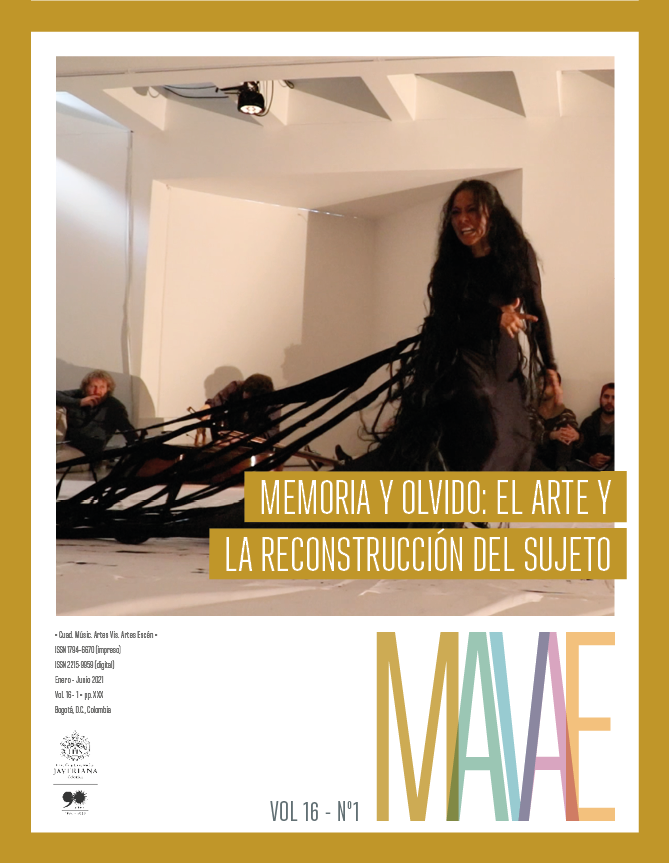Abstract
Gesture: Memory of a Body in Darkness is a performance art that is born from that constant exploration between the inside and the outside, between the identity and the N. N., between the fears and liberations, but always pondering on the incessant question about existence (I am), at the same time that the here and now are being experienced. This is an artistic exhibition related to the study of the personal emotional, affective and creative-discursive process (self-research), through the corporeal scenic, philosophical and plastic languages that are typical of butoh dance. As a researcher, I start from the constant discomfort that promotes the unknown before our body/psyche in relation to life, developing them through laboratories of investigation, experimentation and experiences of body epistemology and technical training typical of butohka aesthetics, to offer a performance art as a sample and final result. During the process, by keeping a field journal of self-study and by presenting the performance art to the audience, feedback is given to multiple visions of the I am, projected and reflected in the others, common conceptions of identity and own findings around early childhood are deployed. Within the processes of human development, it is important to become aware of one’s own existence through the body and the emotions, to create spaces that give feedback to collective memory, and to investigate those collective healing processes that allow the transformation of one’s own experiences around community art in culture and territories
Bergson, Henri. 1930. “Lo posible y lo real”. Consultado: 3 de noviembre de 2020. https://arjai.files.wordpress.com/2016/01/bergson-lo-posibley-lo-real1.pdf.
Bergson, Henri. 1896. Materia y memoria. Barcelona. Atalaya. Davidagudelobernal.com. http://www.davidagudelobernal.com/BIO.html.
Curtis, Helena, N. Sue Barnes, Adriana Schnek y Alisia Mssarini. 2000. Curtis Biología. Buenos Aires: Panamericana.
Deleuze, Gilles. 1968. Différence et répétition. París: Presses universitaires de France.
Deleuze, Gilles. 2002. Diferencia y repetición. Traducido por María Silvia Delpy y Hugo Beccacece. Buenos Aires: Amorrortu.
Deleuze, Gilles y Félix Guattari. 1980. Mille plateaux. París: Les Éditions de Minuit.
Deleuze, Gilles y Félix Guattari. 2002. Mil mesetas: Capitalismo y esquizofrenia. Traducido por José Pérez Vázquez. Valencia: Pre-textos.
Goldberg, Roselee. (2004). Performance: Live Art Since the 60s. Londres: Thames and Hudson.
Jung, Carl Gustav. 1970. Arquetipos e inconsciente colectivo. Barcelona: Paidós.
LAUD 90.4 FM Estéreo. 2018. “Bogotá le tributa un homenaje al profesor butoh Ko Murobushi”. Consultado: 3 de noviembre de 2020. http://laud.udistrital.edu.co/content/bogot%C3%A1-le-tributa-unhomenaje-al-profesor-butoh-ko-murobushi
Le Breton, David. 1999. Las pasiones ordinarias: Antropología de las emociones. Buenos Aires: Nueva Visión.
López, Helena. 2004. “Emociones, afectividad y feminismo”. En Cuerpo yafectividad en la sociedad contemporánea: Algunas rutas del amor y la experiencia sensible en las ciencias sociales, editado por Adriana García Andrade y Olga Sabido Ramos, 257-276. México: Universidad Autónoma Metropolitana.
Mar Velasco, Patricia. 2009. “El cuerpo como sí mismo”. En Cuerpo, sujeto e identidad, coordinado por Norma Delia Durán Amavizca y María del Pilar Jiménez Silva, 139-167. México: Universidad Nacional Autónoma de México.
Myss, Caroline. 1996. Anatomía del espíritu: La curación del cuerpo llega a través del alma. Buenos Aires: Zeta.
Pérez Monjaraz, Nayeli. 2016. “La desterritorialización del cuerpo: Una reflexión acerca de la danza butoh”. Reflexiones Marginales 36. Consultado: 3 de noviembre de 2020. https://reflexionesmarginales.com.mx/blog/2016/11/30/la-esterritorializacion-del-cuerpo-unareflexion-acerca-de-la-danza-butoh/.
Polo Tenorio, Brenda. 2015. “Desco-no-cido”. Consultado: 3 de noviembre de 2020. https://docs.wixstatic.com/
ugd/053f5d_7528dcd93b234600b2fd52b16c4e8bfa.pdf.
Polo Tenorio, Brenda. 2020. “La potencia oculta de la memoria”. Consultado: 3 de noviembre de 2020. https://docs.wixstatic.com/ugd/053f5d_ff7f95fa177c460aaaa1daa823fd27d6.pdf.
Manusdea Antropología Escénica. 2018a. “Las metamorfosis IX”. Consultado: 3 de noviembre de 2020. https://www.youtube.com/watch?v=1UtVWDjI_1E.
Manusdea Antropología Escénica. 2018b. “Butoh laboratorio/Efecto
mariposa”. Consultado: 3 de noviembre de 2020. https://www. youtube.com/watch?v=3MRqO74BuLs.
Red Milenaria. 2020. “El árbol de la vida, Etz hayim”. Consultado: 3 de noviembre de 2020. https://redmilenaria.com/cuaderno-decabala/el-arbol-de-la-vida-etz-hayim.
Restrepo, José Alejandro, Habeas corpus, que tengas un cuerpo para exponer, Museo del Banco de la República, Bogotá. http://www.banrepcultural.org/habeas-corpus/txt02-001.html (19 marzo 2010).
Shibusawa, Tatsuhiko. 2016. “Hijikata y el butoh: Arrancar la oscuridad de la carne. La Jornada Semanal 1101: 7-10. https://issuu.com/lajornadaonline/docs/semanal10042016
Tada, Michitaro. 2006. Gestualidad japonesa: Manifestacionesmodernas de una cultura clásica. Buenos Aires: Adriana Hidalgo.
Vargas Aguirre, Gabriela. 2017. La ruta de la ceniza. Quito: La Caída.

This work is licensed under a Creative Commons Attribution 4.0 International License.
Copyright (c) 2021 Lina Costanza Saavedra Cajamarca


